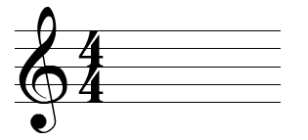Before we can talk about time signature, it would be good to get familiar with the note symbols and their lengths.
2.2.1 NOTE SYMBOLS
The note symbols are figures that indicate the length of a note. A note symbol is formed by the following elements:
For each note symbol, there is a relative rest that has the same length. The rest symbol indicates silence.
In the following table (taken from Beth's music notes), you can see the length of each note symbol, their relative rest symbol, the number of beats it lasts, and how many of these symbols are needed to fill in one bar in 4/4 time (we will see that later):

The following picture can be useful to make things clearer:
2.2.2 TIME SIGNATURE
The time signature is an indication that appears at the beginning of a score, just after the clef:
It is represented by two numbers, one above the other, just like in a fraction.
The time signature specifies how many beats are there in each measure (or bar), and which note value is equivalent to a beat. The upper number indicates the number of beats. The number below indicates which note equals one beat:

So, for example, in a 4/4 time signature, we will have four beats and each beat will be represented by a quarter note. Therefore we will have four quarter notes or any combination that equals four quarter notes:


